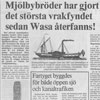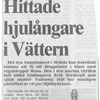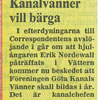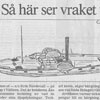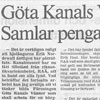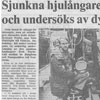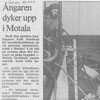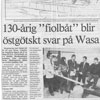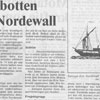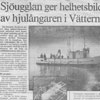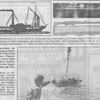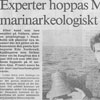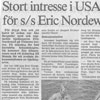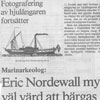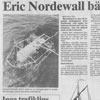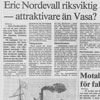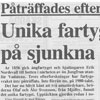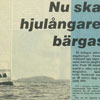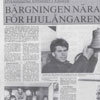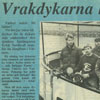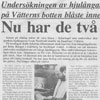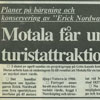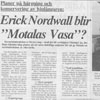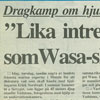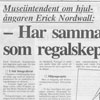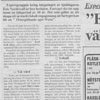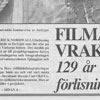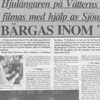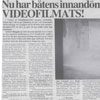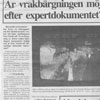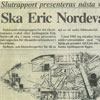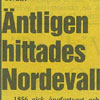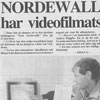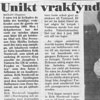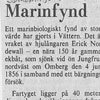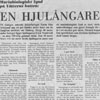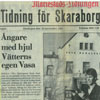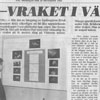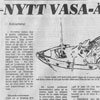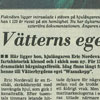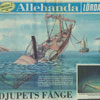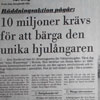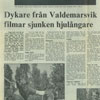Welcome!
The Paddle steamer Eric Nordevall has for decades created a lot of interest far beyond the Swedish borders. Rumours about the vessel have been many and long, ranging from tales of a cargo of cognac to questions as to whether or not the wreck actually should be salvaged.
On this site we will try to tell as complete a story as possible, with stories taken from the past as well as those from today.
This site is a new and unique way to show our marine heritage to the public. Today the Internet is a standard feature in almost every home and here everybody can take part in the amazing story that lies on the bottom of Lake Vättern. No matter where you live, you will be able to experience a wreck in a way that was previously only possible for divers to experience. The site is based on a timeline, starting with the past and continuing until the present day.
This site has been created by the group that runs the project Divepark Vättern. In their quest to create a divepark in Lake Vättern, featuring the wreck of the Eric Nordvall as the main attraction, the group noticed a huge interest from the public. The material collected and produced during the divepark project enabled this page to be created.
Read more about the project on http://www.dykparkvattern.se/eng
History
The Eric Nordevall was built at Hammarsten's shipyard in Norrköping in 1836-37. The vessel was designed by naval officer Johan Gustaf von Sydow. She was one of five sister ships, Admiral von Platen, Daniel Thunberg, Thomas Telford, Christopher Polhem and Eric Nordvall. All had been named after famous canal builders or mechanical engineers.
The hull was launched in August 1836 and towed to Motala Verkstad in Motala where the steam engines and paddle wheels were installed. The steam engines were of a side lever design and developed 17 horsepower each.
According to the book ”Vrak i Svenska vatten” ("Shipwrecks of the Swedish Water") written by Claes-Göran Wetterholm, the two steam engines worked independently. He describes a sequence of events at one of the wood stations.
"At one point it was taking on wood at one of the wood stations, however the crew failed to stop one of the engines ... this led to the ship going around and around, and each time they crossed the dockside they were throwing the wood onboard“
(Vrak i Svenska vatten, 1994, s.207-208, Wetterholm)
The steam engines were quickly installed, by October they were both in place. They were then able to perform a test drive and stability test in Vättern before it was time to return to Hammarstens shipyard to complete the construction and fit the last parts.
By May 1837, the Eric Nordvall was complete and she was registered and measured in Stockholm.
After the registration the Eric Nordevall sailed on Lake Mälaren until October of the same year. She was then loaned to the Royal Post Office to transport mail between Ystad and Stralsund.
For two months the Eric Nordevall sailed between Ystad and Stralsund before she finally commenced sailing the Stockholm - Gothenburg route via the Göta Kanal.
Ship facts:
Year: 1836Shipyard: Hammarsten's Row in Norrköping
Length: 26,5 meters
Maximum width: 6,4 meters
Depth: 2,6 meters
Machine: Two balance steam engines on each 17hp
Cruising Speed: approx 7 knots
Source: Vrak i Svenska Vatten, Claes-Göran Wetterholm
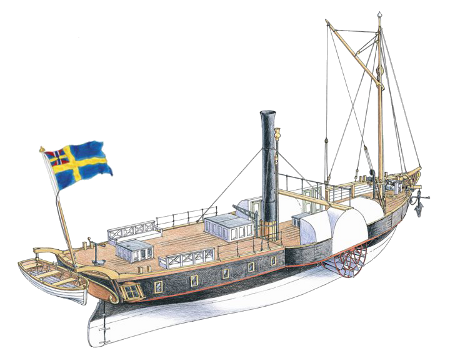
Illustration: Föreningen Forsviks Varv
The sinking
The Eric Nordevall had sailed the Göta Kanal for 19 years when she left the dock at Vadstena castle on the morning of the 4th of June, 1856. During the night and early morning passengers had left or boarded the boat, and on the rear deck liquor had been loaded from the warehouse at the castle.
few hours outside of the harbour Captain Bergström left the rudder to helmsman Eriksson and went down to his cabin. Not long after helmsman Eriksson handed the rudder over to his fellow crewman Eliasson.
Before leaving for his cabin, he told Eliasson; "you can go as close as possible to the island Jungfrun". Eliasson considered it to be better safe than sorry and held out a few hundred meters north of Jungfrun. However he was unaware that this course took him over a shallow shoal ground. Sometime between two and three o'clock in the afternoon the Eric Nordevall ran aground. The bow lifted and the paddles splashed water in every direction as the engines started spinning faster.
The Eric Nordevall was firmly aground.
They fired the signal cannons for help and the steam ship Motala Ström came from a nearby island. The passengers and cargo were moved to the Motala Ström before they tried to pull the Eric Nordevall free. However theattempt failed and the Eric Nordeval remained firmly aground. She was left behind whilst the passengers and cargo were carried back to land.
Two days later, on the 6th of June, 1856 the two steam corvettes Santesson and Föreningen set out to make another attempt to pull the Eric Nordevall free of the shoal. With the two boats pulling and with the help of the Eric Nordvalls own engines they finally succeeded in freeing her. However after a few minutes of towing, they noticed that she was taking in water and had started to sink.
The tow lines were cut and the Eric Nordvall sank east of the island Jungfrun.
Rediscovery
Many had searched for the Eric Nordvall over the years, but had failed to find her. The information about where she sank became more and more blurred as the years went by but the story lived on. Rumors were created and from leaving Vadstena with plain vodka, it had turned into the finest cognac.
During a trip to the town of Karlsborg, Olaf Svensson saw a list of wrecks in Vättern where one was still missing, the paddle steamer Eric Nordvall. Olaf and his brother Åke were both divers so they quickly took an interest in the missing wreck. Their only problem was that they did not have any equipment to search for old shipwrecks, all they had was a small inflatable boat. Åke was at that time working at a company in Motala which used steel wire to attach the lights in the ceiling of large buildings. The brothers came up with the idea that maybe they could use steel wire to find the wreck.
Åke and Olaf had the idea that if they put a weight on one end of the wire and then pulled it out behind the boat, they could tighten it against the seafloor by lowering another weight directly below the boat when the wire was dragged out from the fist weight. They could then attach the remainder of the wire to the boat and slowly drive the boat in a circle around the first weight. To see where the first weight was they put a line up to the surface from the weight with a buoy at the end. If the wreck were within the circle the wire would go around the wreck and make the weight and buoy in the middle move sideways when they continued to drive the boat in a circle. Åke and Olaf had tested their idea by using sewing thread and two Lego pieces at home on the carpet. It worked as they thought, so they decided to test it in practice.
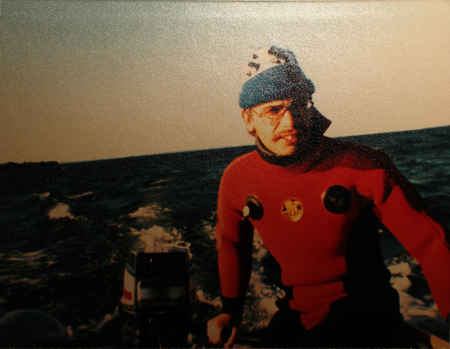
Åke Svensson is searching in his small inflatable boat.
They started searching close to the island of Jungfrun where the Eric Nordvall ran aground. The bottom in the lake usually consists of sand and mud, but it turned out that near the island there were large rocks on the bottom. At first the wire got stuck under the rocks, and initially they dived down and loosened the wire before they realised that if they just pulled a little harder with the boat, they could pull the wire under the rocks instead. When they had finished one circle they just pulled the wire with weights to the next area they would search.
The two brothers were out searching with the little rubber boat every weekend, both Saturday and Sunday for about two months before they found something. They had just finished one circle and were about to pull the wire to the next area they would scan, when Olaf suddenly saw that the buoy in the middle start to move sideways. At that time the engine started struggling a bit extra and it was hard to pull the wire. After a while the wire got stuck and then they knew they had found something big.
When they had tested at home on the carpet and pulled the thread around an object, the Lego piece in the middle had moved towards the object and finally got stuck next to it, so they thought it would behave the same way at a wreck. They quickly put on their diving gear and jumped in next to the buoy at the center weight and went down to see what they had found. It quickly became deep and when they reached the bottom at 45m they saw the wire continued along the bottom with no wreck in sight. Since they had about 200-300m of wire they did not know how long it would continue across the bottom of the lake and their time at depth was short. They aborted the dive and went back up to the surface. Back in the boat again they decided to go back to the other end of the wire and start to pull the wire until they had the point where it was stuck straight under the boat. They pulled the wire until it pointed vertically down under the boat, at this point they saw that they were about 50m away from the second buoy. The wreck had to be below them.
After the deep dive earlier it was necessary for them to remain on the surface for a few hours before they could dive again, and they had no air in their tanks, so they left the wire and the buoys and went back home without knowing what they had found. They went back the day after to dive and see what they had found.
The buoys had remained in the same place that they had left them so they quickly changed into their dive gear and jumped into the water and followed the wire to the bottom. At about 30m deep, the wire was tangled around a wooden pole. They did not understand what it was until they came down and saw the deck of the wreck. It was the mast of the wreck still standing with the wire wrapped around it. Åke and Olaf came down onto the deck and saw the windlass standing right in front of the mast and four signal cannon sitting in pairs on each side of the railing. Everything was pristine and untouched, just as it had been when she went to the bottom.
The ships bell was still hanging on the mast, they looked at it and read, Erick Nordwall.
Articles

The Eric Nordevall has over the years created a variety of headlines, many of them long before the digital archives existed. Articles that over the years have been forgotten and only a few people had them in their personal archives.
We came across a large collection from the time when Eric Nordevall was found and a few years after. All articles have been scanned and then organized by date and origin.
By working with several newspapers, we have been authorized to publish them so that they once again become available to the public.
Unfortunately all the articles are written in Swedish but they are worth looking at just because of the images and illustrations in them.
Click on the logo for each newspaper to see all articles.
Photos
During the documentation of the wreck, a large number of photographs were taken by several photographers who participated in the project.
Below you can see a selection of these images.
360° Photos
During the dives undertaken on the Eric Nordvall in 2010-2011, the divepark Vättern project members realised that there was a lot of interest from the public and those who could not dive.
The debate on salvage came up again because some people felt that the plans with divepark only would benefit only the divers and not the broader public. Everyone should have access to the wreck.
This became a bit of a spur for the group and they began to explore all the possibilities of how to show people who do not dive what the wreck looks like. Photos and video will give a understanding to a certain level but the viewer doesn’t get the feeling of being on the wreck with active choices on what he/she wants to see. One of the projects’ partners, The Swedish Maritime Museum had for some time experimented with taking visitors out to wreck sites and then showing live video using an underwater robot or ROV (Remote Operated Vehicle). This gave a sense of participation and a great experience but it is very expensive. For a number of years, a photographic technique was used in online sales of apartments and buildings that made it possible for a person to stand inside a room without being on site. This is was called spherical photography or 360 ° photography.
This technique had been tested under the water a few times earlier in tropical clear waters with varying results. No one had really been able to get good quality pictures.
The wreck of the Eric Nordvall is at a depth of 45m in dark cold waters so there was nothing to compare it with. For a year the group experimented with different solutions before they found one that worked. The pictures have received enormous attention and it finally gives people who do not dive a sense of what it is like to be on the wreck.
Welcome down to the Eric Nordevall!
3D
Since the 360 ° photographs were first made public in the autumn of 2011, they have received enormous attention both in Sweden and far beyond its borders.
The company wec360 who helped develop the technology that was used on the Eric Nordevall formed the brand wecOcean together with Erik Rådström where they offered 360 ° photos underwater. As part of the development, and in order to offer its customers a complete package to show wrecks, they used material from the documentation of the Eric Nordvall to create a 3D model of the wreck. The 3D model complements the previously captured 360 ° images to create a total overview of the wreck.
Using drawings and measurements obtained from Forsviks shipyard, who were building a full-scale replica of Eric Nordevall, they first built the body of wreck in a 3D program. When the frame was finished, pictures and video were used to help create the surfaces so that it would look as similar to the actual wreck as possible.

The 3D modeling starts with a rough body before the surface is applied to create a lifelike appearance.
When the 3D model is complete, it can be used in several different ways. It can be used to create still images, video sequences, or as a rotating model.
At this time the company 3deepmedia in England had developed their own version of a program that made it possible to add so-called hot spots in a rotating 3D model. A hotspot is a point or place on the 3D model in which still images, videos and 360 ° views can be integrated. Previously, it had not been possible to integrate hotspots in a rotating 3D in this way.
Thanks to the new partnership, you can now rotate a model of the Eric Nordvall and get an overview of how it looks down at the wreck site and at the same time take a step onboard thanks to the 360° images.












